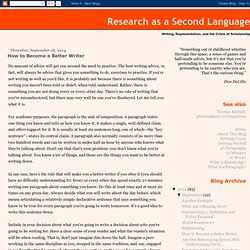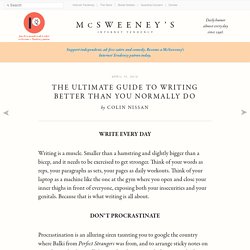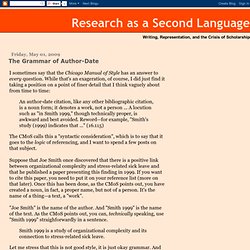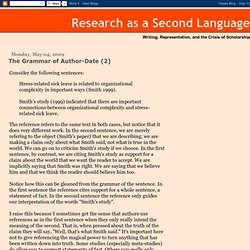

The Habits of Highly Productive Writers - Advice. By Rachel Toor Many writers I know love Joyce Carol Oates—some even refer to her as JCO, as if she were a brand as recognizable as CBS or BMW.

But just as often, the mention of her name is met by groans and complaints about how much she’s written. Her productivity seems like an affront. When someone’s doing a lot more than you, you notice it. It brings out your petty jealousy. So I started to think about the practices of highly productive writers. They reject the notion of "writer’s block" the way others shun gluten. Productive writers don’t reach for excuses when the going gets hard. They don’t overtalk their projects. They believe in themselves and their work. How to Become a Better Writer. No amount of advice will get you around the need to practice.

The best writing advice, in fact, will always be advice that gives you something to do, exercises to practice. If you're not writing as well as you'd like, it is probably not because there is something about writing you haven't been told or didn't, when told, understand. Rather, there is something you are not doing every or every other day. There's no rule of writing that you've misunderstood, but there may very well be one you've disobeyed.
Let me tell you what it is. For academic purposes, the paragraph is the unit of composition. Scholarly Writing Hacks: 5 Lessons I Learned Writing Every Day in June. [This is a guest post by Jennifer Ahern-Dodson, an assistant professor of the Practice in Writing Studies at Duke University where she teaches digital storytelling and researches learning communities and community-university partnerships.

You can follow her on Twitter @jaherndodson. --@JBJ] On May 31st panic set in.
Break Out of Your Lack-of-Feedback Loop. Does this ever happen to you?

Let’s say you’re writing an article or a chapter. It’s taking longer than you anticipated. (No surprise there.) Your editor or your dissertation advisor, or maybe just your writing group, is expecting to read a draft, but you think it’s not ready. It’s incomplete, it’s tentative, it doesn’t adequately review the secondary literature, it doesn’t take into account a source you haven’t read yet. This scenario probably describes the writing life of too many graduate students and, I suspect, many other writers even after graduate school. You show your work in progress to other people because it’s not good enough. But comments and corrections, as helpful as they are, aren’t the most useful result of sharing your work. I’m convinced that the hardest part about writing academic work is the lack of an audience, or more precisely, the long gap between the time you start writing and the time your readers start reading.
The Ultimate Guide to Writing Better Than You Normally Do. Writing is a muscle.

Smaller than a hamstring and slightly bigger than a bicep, and it needs to be exercised to get stronger. Think of your words as reps, your paragraphs as sets, your pages as daily workouts. 7 Ways to Survive a Lit Review. [Image by Flickr user JKim1 and used under Creative Commons License This summer I experienced a grad student rite of passage: crafting a review of literature.

The way was fraught and I had to overcome everything from an avalanche of articles (let’s just say my snowball method raged out of control) to a complete inability to conceive of any kind of organization. I also developed fascinating new ways to procrastinate. Thankfully, I follow #phdchat on Twitter, and the participants’ sage words on the process helped me move from a state of near paralysis to fruitful, concentrated writing sessions.
Maintain your Lit Review, Maintain your Sanity. The Grammar of Author-Date. I sometimes say that the Chicago Manual of Style has an answer to every question.

While that's an exageration, of course, I did just find it taking a position on a point of finer detail that I think vaguely about from time to time: An author-date citation, like any other bibliographic citation, is a noun form; it denotes a work, not a person ... A locution such as "in Smith 1999," though technically proper, is awkward and best avoided. Reword—for example, "Smith's study (1999) indicates that ... " (16.115) The CMoS calls this a "syntactic consideration", which is to say that it goes to the logic of referencing, and I want to spend a few posts on that subject.
Suppose that Joe Smith once discovered that there is a positive link between organizational complexity and stress-related sick leave and that he published a paper presenting this finding in 1999. "Joe Smith" is the name of the author. The Grammar of Author-Date (2) Consider the following sentences: Stress-related sick leave is related to organizational complexity in important ways (Smith 1999).Smith's study (1999) indicated that there are important connections between organizational complexity and stress-related sick leave.

The reference refers to the same text in both cases, but notice that it does very different work. In the second sentence, we are merely refering to the object (Smith's paper) that we are describing; we are making a claim only about what Smith said, not what is true in the world. We can go on to criticize Smith's study if we choose. In the first sentence, by contrast, we are citing Smith's study as support for a claim about the world that we want the reader to accept. Notice how this can be gleaned from the grammar of the sentence. I raise this because I sometimes get the sense that authors use references as in the first sentence when they only really intend the meaning of the second.
Mind Your En And Em Dashes: Typographic Etiquette. Advertisement An understanding of typographic etiquette separates the master designers from the novices.

A well-trained designer can tell within moments of viewing a design whether its creator knows how to work with typography. Typographic details aren’t just inside jokes among designers. They have been built up from thousands of years of written language, and applying them holds in place long-established principles that enable typography to communicate with efficiency and beauty. Handling these typographic details on the Web brings new challenges and restrictions that need to be considered. Setting Body Copy Good typography comes down to communicating information, and the basis of information is good old-fashioned body copy – simple blocks of text. Indentation or Space After a Paragraph? When signalling the end of a paragraph and the beginning of another, you can generally either indent or insert a space between the paragraphs.